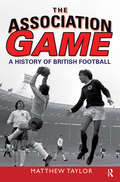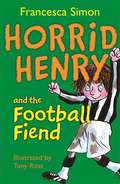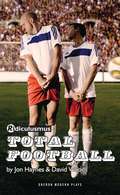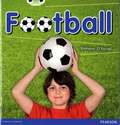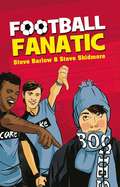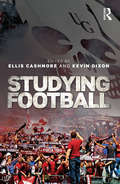Special Collections
Fantastic football!
Description: Football inspired resources - both accessible images and titles - both fiction and non fiction! Aimed at children and young people reading.
- Table View
- List View
The Association Game
by Matthew TaylorThe story of British football's journey from public school diversion to mass media entertainment is a remarkable one. The Association Game traces British football from the establishment of the earliest clubs in the nineteenth century to its place as one of the prominent and commercialised leisure industries at the beginning of the twenty first century. It covers supporters and fandom, status and culture, big business, the press and electronic media and development in playing styles, tactics and rules. This is the only up to date book on the history of British football, covering the twentieth century shift from amateur to professional and whole of the British Isles, not just England.
Horrid Henry and the Football Fiend
by Francesca SimonHorrid Henry reads Perfect Peter's diary and improves it. He goes clothes shopping with Mum and tries to make her buy him some Rootatoot trainers. He is horrified when his old enemy Bossy Bill turns up at school. And he tries by any means, fair or foul, to win the class football match and defeat Moody Margaret.
Total Football
by David Woods and Jon HaynesFootball systems, changing room banter and a couple of mops solve the big questions of life – immortality, happiness and why England always lose, in a new play tackling the beautiful game.After several years of embedded research in the football darklands, a failed attempt to create a UK football team for the 2012 games and pathetic efforts at understanding the offside rule, Ridiculusmus is patching up its metatarsals to examine the melting pot of what it means to be British today.
Paralympic 7-a-side football (Large Print)
byThis page has three images on it: a player trying win the ball from an opponent, a goalkeeper attempting to save a ball, and a diagram showing the layout of a 7-a-side pitch. Players have cerebral palsy or stroke damage of varying severity. Each image has a dashed line image border. There is a locator dot shown, which will be at the top left of the page when the image is the correct way up.A player trying win the ball from an opponent - The image on the top left of the page shows two players and a ball. The player on the left of the image is seen from the side and facing right, so only one eye can be found. He has his arms stretched out to the left and right. He is running, and one leg extends straight to the left. On the right, his other leg is bent with the ball on the ground, just to the right of his foot. The player to the right of the image is seen from the side facing to the left so that only one eye can be found. He has his arms stretched out left and right. His leg to the left is controlling the ball to the left of his foot. To the right his other leg is bent to the right, ready to swing left and kick the ball away from his opponent.A goalkeeper attempting to save a ball - This image, at the bottom left of the page, shows a goalkeeper, a ball and part of the goal net. The goalkeeper has leapt towards the ball, which is in the top left of the image. He has his arms outstretched and his hands are near the ball, ready to catch it. The rest of the keepers body extends diagonally down across the page with both of his legs stretched out in the bottom right of the image. The square grid of the goal net can be found filling the remainder of the image border.Diagram of 7-a-side football pitch - This diagram on the right of the page shows the football pitch and seven members of each team. The players are represented here by large dots and crosses. The pitch is 40 metres wide by 60 metres long. At the top centre of the page there is a small rectangle representing a goal. Down the page from this are the goal area with a goalkeeper, and the penalty area with the penalty spot. Down again is the penalty arc; all players must stay outside of this area when a penalty is being taken. Further down the page are the centre circle, the centre spot, and the centre line going across the image horizontally. At the bottom of the image is the opposing team's goal and penalty area.
Paralympic 7-a-side football (UEB Contracted)
byThis page has three images on it: a player trying win the ball from an opponent, a goalkeeper attempting to save a ball, and a diagram showing the layout of a 7-a-side pitch. Players have cerebral palsy or stroke damage of varying severity. Each image has a dashed line image border. There is a locator dot shown, which will be at the top left of the page when the image is the correct way up.A player trying win the ball from an opponent - The image on the top left of the page shows two players and a ball. The player on the left of the image is seen from the side and facing right, so only one eye can be found. He has his arms stretched out to the left and right. He is running, and one leg extends straight to the left. On the right, his other leg is bent with the ball on the ground, just to the right of his foot. The player to the right of the image is seen from the side facing to the left so that only one eye can be found. He has his arms stretched out left and right. His leg to the left is controlling the ball to the left of his foot. To the right his other leg is bent to the right, ready to swing left and kick the ball away from his opponent.A goalkeeper attempting to save a ball - This image, at the bottom left of the page, shows a goalkeeper, a ball and part of the goal net. The goalkeeper has leapt towards the ball, which is in the top left of the image. He has his arms outstretched and his hands are near the ball, ready to catch it. The rest of the keepers body extends diagonally down across the page with both of his legs stretched out in the bottom right of the image. The square grid of the goal net can be found filling the remainder of the image border.Diagram of 7-a-side football pitch - This diagram on the right of the page shows the football pitch and seven members of each team. The players are represented here by large dots and crosses. The pitch is 40 metres wide by 60 metres long. At the top centre of the page there is a small rectangle representing a goal. Down the page from this are the goal area with a goalkeeper, and the penalty area with the penalty spot. Down again is the penalty arc; all players must stay outside of this area when a penalty is being taken. Further down the page are the centre circle, the centre spot, and the centre line going across the image horizontally. At the bottom of the image is the opposing team's goal and penalty area.
Paralympic 5-a-side football (UEB Contracted)
byThis page has three images on it: a player trying to stop an opponent passing the ball, two players trying to gain possession of the ball, and a diagram showing the layout of a 5-a-side pitch. All players have sight problems and wear blindfolds. The ball makes a noise to help players locate it and sighted goalkeepers are allowed to shout instructions to players. Each image has a dashed line image border. There is a locator dot shown, which will be at the top left of the page when the image is the correct way up. Player trying to stop an opponent passing the ball. - The image on the top left of the page shows two players and a football. The player to the left is facing to the right, his face in profile and his body twisted so it is facing you. He has his arms extended out to the left and right. One leg is going down the page and left, the other is reaching out to the right and almost touching the ball further right. On the right of the image, an opposing player is facing left with his face in profile and his body turned to face you. His arms reach out to the left and right. He has his foot to the right lifted up, ready to kick the ball and pass it to a teammate.Two players trying to gain possession of the ball - This image, at the bottom left of the page, shows two players and a football. On the left of the image, a player is seen from the side facing right. He has his arms stretched out to the left and right and he is supported on one leg, while his other leg extends out to the right trying to make contact with the ball above. The opposing player on the right of the image is facing left and seen from the side. With his arms stretched out to the left and right, he is running towards the other player to tackle him and try to take possession of the ball.Diagram of a 5-a-side football pitc: This diagram is on the right of the page. The two teams are represented by large dots and crosses. At the top of the image is a goal shown as a small rectangle. Down the page from this is the penalty area and penalty spot. Going across horizontally in the centre of the image, is the halfway line, with the centre spot and centre circle in the middle. The layout in the top of the diagram is mirrored in the bottom. The playing area is 140 feet x 85 feet. The two teams, dots and crosses, have adopted different playing positions. Apart from the last man's in defence near the goal, many teams do not have fixed roles for players. This allows a more fluid game with players reacting to the game as it progresses.
Bug Club, Blue, B (ks1)
by Eamonn O'FarrellLots of people like to play football. Learn more about the game in this book.
Read On
by Steve Barlow and Steve SkidmoreIt's not easy supporting the bottom team in the football league . My team, Mudchester United have been drawn against Kingston FC in the FA Cup! Kingston won the Premier League last year. Their team is stuffed full of famous players from all over the world. This will be the biggest game ever in Mudchester's history. Alex Beasley is a football fanatic. He dreams that one day his favourite team will play at Wembley in the FA Cup final. Sadly, this is not likely to happen, because the team he supports is Mudchester United, the worst club in the Football League. Could this season be different? When Mudchester are drawn against a premiership side in the FA Cup, could they turn out to be this year's giant killers? Help Key Stage 3 students move from Level 3b to Level 3a in reading. Support comprehension with the funny, age-appropriate illustrations. Encourage shared and guided reading using the ready-made tasks and discussion points on the activity pages at the back of the book. Suitable for Key Stage 3 students with a reading age of 9 years.
The Big Football Collection
by Rob ChildsA terrific football treble from the master of soccer fiction. The Big Game: Keen young footballer Andrew Weston is sure that his skills in defence will help the school team win every match. Until he discovers who their first opponents are ... The Big Match:nbsp;A dream comes true for Chris Weston when he is picked to stand in for the school team's regular goalkeeper for a vital cup game. The Big Prize:nbsp;Chris Weston is going to be the mascot for the local football league club for their next F.A. Cup match! Then disaster strikes ...
Football (UEB contracted)
by RnibThis page has three images on it: a player about to kick the ball past an opponent, a goalkeeper attempting to save a ball, and a diagram showing the layout of a football pitch. Each image has a dashed line image border. There is a locator dot shown, which will be at the top left of the page when the image is the correct way up. A player about to kick the ball past an opponent: The image on the top left of the page shows two players and a ball. The player on the left of the image is seen from the side and facing right, so only one eye can be found. He has his arms stretched out to the left and right. He is running, and one leg extends straight to the left. On the right, his other leg is bent up slightly. He wears a red shirt and white shorts (large print copy). The player to the right of the image is seen from the side facing to the left so that only one eye can be found. He has his arms stretched out and down to left and right. He stands on the leg to the left. To the left the ball sits on the grass. To the right his other leg is bent to the right, ready to swing left and kick the ball past his opponent. He wears a black and white striped shirt and black shorts (large print copy). A goalkeeper attempting to save a ball: The image at the bottom left of the page shows a goalkeeper, a ball and the goal. The goalkeeper has leapt off the ground towards the ball, which is in the top left of the goal. He has his arms outstretched and his hands are near the ball, ready to catch it. The rest of the keeper's body extends diagonally down and right. The square grid of the goal net can be found filling the goal posts behind him. Diagram of a football pitch: This diagram on the right of the page shows the football pitch and eleven members of each team. The players are represented here by large dots and crosses. At the top centre of the page there is a small rectangle representing a goal. Down the page from this are the goal area with a goalkeeper, and the penalty area rectangle with the penalty spot. Down again is the penalty arc, a semi-circle; all players must stay outside of this area when a penalty is being taken. Further down the page are the centre circle, the centre spot, and the centre line going across the image horizontally. At the bottom of the image is the opposing team's goal and penalty area. The pitch is on average 115 yards long x 75 yards wide (106 x 70 metres). Pitches, even in the Premier League, vary slightly across the country. Before the match starts and after a goal has been scored the players position themselves in various formations. The team at the top of the page is in 4:3:3 formation. That is four forwards, three mid-fielders and three defenders. The team at the bottom are in 4:4:2 formation, four forwards, four mid-fielders and two defenders. There are many other possibilities but these are some of the commonest.
Football (UEB uncontracted)
by RnibThis page has three images on it: a player about to kick the ball past an opponent, a goalkeeper attempting to save a ball, and a diagram showing the layout of a football pitch. Each image has a dashed line image border. There is a locator dot shown, which will be at the top left of the page when the image is the correct way up. A player about to kick the ball past an opponent: The image on the top left of the page shows two players and a ball. The player on the left of the image is seen from the side and facing right, so only one eye can be found. He has his arms stretched out to the left and right. He is running, and one leg extends straight to the left. On the right, his other leg is bent up slightly. He wears a red shirt and white shorts (large print copy). The player to the right of the image is seen from the side facing to the left so that only one eye can be found. He has his arms stretched out and down to left and right. He stands on the leg to the left. To the left the ball sits on the grass. To the right his other leg is bent to the right, ready to swing left and kick the ball past his opponent. He wears a black and white striped shirt and black shorts (large print copy). A goalkeeper attempting to save a ball: The image at the bottom left of the page shows a goalkeeper, a ball and the goal. The goalkeeper has leapt off the ground towards the ball, which is in the top left of the goal. He has his arms outstretched and his hands are near the ball, ready to catch it. The rest of the keeper's body extends diagonally down and right. The square grid of the goal net can be found filling the goal posts behind him. Diagram of a football pitch: This diagram on the right of the page shows the football pitch and eleven members of each team. The players are represented here by large dots and crosses. At the top centre of the page there is a small rectangle representing a goal. Down the page from this are the goal area with a goalkeeper, and the penalty area rectangle with the penalty spot. Down again is the penalty arc, a semi-circle; all players must stay outside of this area when a penalty is being taken. Further down the page are the centre circle, the centre spot, and the centre line going across the image horizontally. At the bottom of the image is the opposing team's goal and penalty area. The pitch is on average 115 yards long x 75 yards wide (106 x 70 metres). Pitches, even in the Premier League, vary slightly across the country. Before the match starts and after a goal has been scored the players position themselves in various formations. The team at the top of the page is in 4:3:3 formation. That is four forwards, three mid-fielders and three defenders. The team at the bottom are in 4:4:2 formation, four forwards, four mid-fielders and two defenders. There are many other possibilities but these are some of the commonest.
The Big Football Collection
by Rob ChildsA terrific football treble from the master of soccer fiction. The Big Game: Keen young footballer Andrew Weston is sure that his skills in defence will help the school team win every match. Until he discovers who their first opponents are ... The Big Match:nbsp;A dream comes true for Chris Weston when he is picked to stand in for the school team's regular goalkeeper for a vital cup game. The Big Prize:nbsp;Chris Weston is going to be the mascot for the local football league club for their next F.A. Cup match! Then disaster strikes ...
Studying Football
by Ellis Cashmore and Kevin DixonFootball is the most widely played, watched and studied sport in the world. It’s hard to develop a full understanding of the significance of sport in global society without understanding the significance of football. Studying Football is the first book designed specifically to guide and support the study of football on degree-level courses, across the full range of social-scientific perspectives. Written by a team of leading international football experts, and considering themes of globalization, corporatization and prejudice and discrimination throughout, it introduces key topics in football studies, including: media and celebrity identity, fandom and consumption gender violence racism corruption Every chapter includes up-to-date case study material, a ‘Research in Action’ section and features to aid student understanding and bring theory to life. Studying Football introduces all the key themes and facets of the social-scientific study of football, and is therefore an essential text for students on football studies courses and useful reading for any undergraduates studying the sociology of sport more generally.
